Catalpa Tree: Types, Leaves, Flowers, Seed Pods (Including Catalpa Worms) – With Pictures
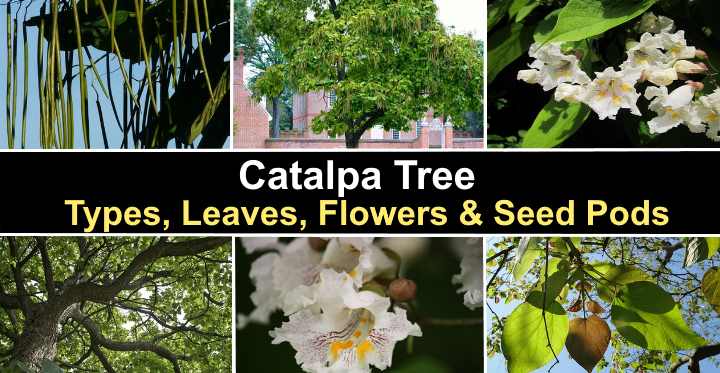
Catalpa trees are deciduous ornamental shade trees with large, heart-shaped leaves, white or yellow fragrant flowers, and long dangling seed pods. Trees in the genus Catalpa are native to North America. The two most common species are the southern catalpa (Catalpa bignonioides) and the northern catalpa (Catalpa speciosa). Catalpa trees are also the food source for catalpa worms.
How to Identify Catalpa Trees
Catalpa trees are easily identified by their scaly grayish, brown bark and an oval crown consisting of large, pointed leaves growing in whorls of three. Catalpas have showy, trumpet-shaped white spring blooms. The most recognizable catalpa tree feature is their long, slender seed pods appearing in fall and persisting until winter or even spring.
This article is a guide to identifying the most common species of catalpa trees. Pictures and descriptions of catalpa leaves, flowers, and seed pods will help you recognize various tree species.
About Catalpa Trees – What is a Catalpa Tree?
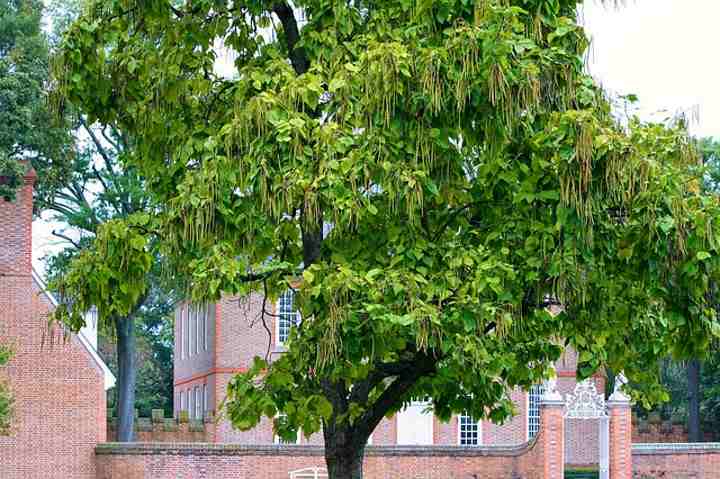
Catalpa tree is identified by its long and slender seed pods
Catalpa is a genus of flowering trees that grow in warm temperate regions of the world. Two species—the northern catalpa and southern catalpa—are native to North America. The other common type of catalpa tree is the Chinese catalpa (Catalpa ovata), which is native to China.
Catalpa trees are typically fast-growing trees that grow between 1 and 2 ft. (0.3 – 0.6 m) per year. The mature height of catalpa trees is usually around 50 ft. (15 m). Catalpa trees grow for 50 to 150 years.
Catalpa tree species grow best in full sun and are adaptable to growing in various soil types.
Most people plant catalpa trees in front or backyards as ornamental shade trees. The spreading rounded canopy is made up of large, broadly heart-shaped leaves. There is also plenty of visual appeal of growing a catalpa tree in a garden landscape. Showy white flowers blossom in spring, followed by slender seed pods that grow up to 20” (50 cm) long.
Northern catalpa vs. southern catalpa
The two native species of the catalpa tree can be challenging to tell apart. The northern catalpa is taller than the southern catalpa and has a narrower, oval crown. Comparing the foliage, the northern catalpa has larger leaves, measuring up to 10” (25 cm) long. In contrast, the southern catalpa’s leaves are between 4” and 8” (10 – 20 cm).
Another distinguishing feature of northern and southern catalpas is the seed pods. Northern catalpas have longer seed pods that can be 24” (60 cm) long, while the southern catalpa has 12-inch (30-cm) long seed pods.
Additionally, northern catalpas are cold-hardier than the southern species and can grow in USDA zones 4 – 8. Southern Catalpas are cold-hardy in zones 5 – 9.
Catawba Worms
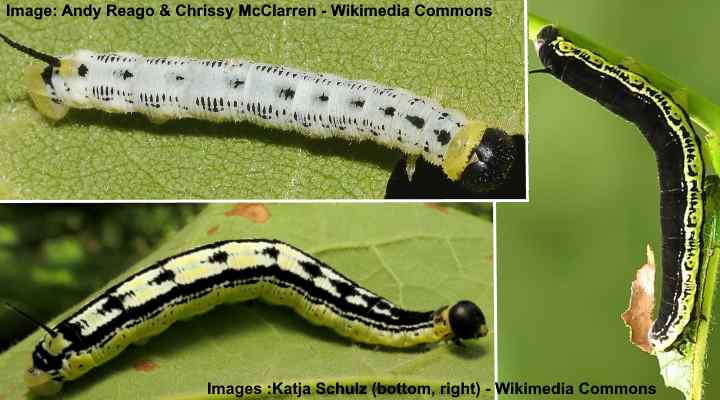
Various instars of Catawba worms (Ceratomia catalpae)
Catawba worms (Ceratomia catalpae) are the larvae of the catalpa sphinx moth. The worms feed exclusively on catalpa tree leaves and munch their way through a tree’s foliage in a short time. Catawba worms are prized by southern fishermen and are a prime source of fish bait in summer.
Also called catalpa worms, the caterpillars are typically dark-colored or black with a yellow underside in their last instar. The long, plump catawba caterpillars have black lines of dots on their back as well as dots on their yellow sides. Catawba worms become brown or gray catalpa sphinx moths after the pupa stage.
Catalpa Seed Pods (Bean Pods)
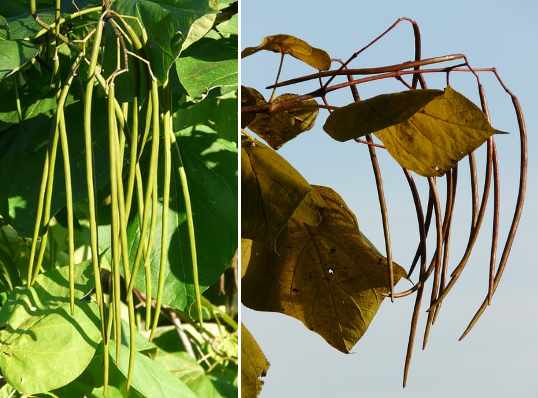
Immature green Catalpa seed pods (left) and mature brown seed pods (right)
Northern catalpa and southern catalpa trees are famous for their long pods containing several seeds or beans. Depending on the species, catalpa seed pods grow between 12” and 24” (30 – 60 cm) long. Masses of pods dangle from catalpa trees from fall through winter.
The seed pods on catalpa trees look green and gradually turn dark brown. The pods contain winged seeds that float on breezes after the pods split open.
Due to the unusual bean pods, catalpa trees have various common names. For example, ‘cigar tree,’ ‘bean tree,’ ‘Indian cigar tree,’ and ‘smoking bean tree’ are a few names for catalpas.
Some people wonder if catalpa tree beans are poisonous. The catalpa seeds in the cigar-like pods are said to be non-toxic. However, people typically don’t eat the seeds—even though they look like beans—because they have no discernible taste or nutritional content.
Catalpa Leaves
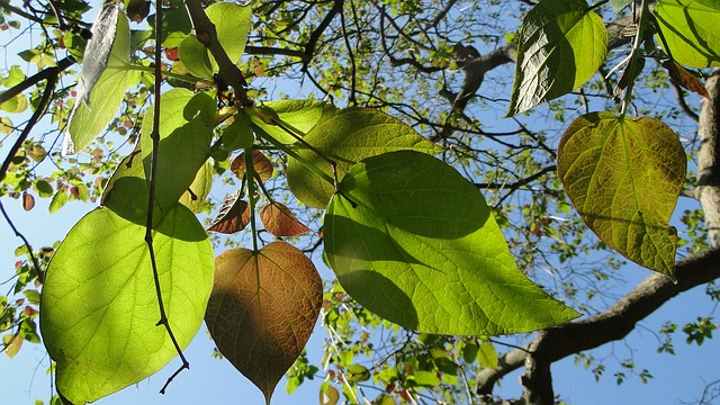
Close up picture of Catalpa leaves
Catalpa trees are known for their broad, triangular-shaped, or heart-shaped leaves. Each leaf has a rounded base at the stem end and a short, pointed tip. Catalpa leaf margins are smooth, with no serration or lobes.
Catalpa leaves often grow in whorls, with three leaves per node. The upper side of the leaves is dark green, and they have a paler green underside. The fall color of northern catalpa trees is typically yellow or brown. However, the leaves of both the southern and northern species often fall from trees while still green.
The catalpa’s large leaves and spreading canopy make these ideal shade trees for residential gardens.
Catalpa Flowers
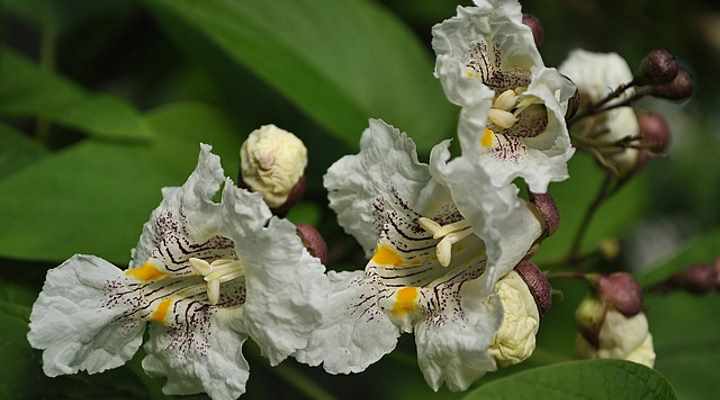
Catalpa flowers have papery white petals with purple patterns in the center and yellow dots
A beautiful characteristic of catalpa trees is their masses of showy white spring flowers. Catalpa flowers are in the shape of a trumpet or funnel and have papery white petals. The white flowers have purple patterned dots in the center and yellow spots. In mid to late spring, the clusters of flowers cover the tree’s foliage.
Northern catalpa flowers are the first of the Catalpa species to bloom in spring. The white bell-shaped flowers have purple spots and stripes with yellow dots. Southern catalpa flowers bloom in summer and look like the northern catalpa flowers. Chinese catalpa flowers are smaller than the other species and look like orchid flowers.
Types of Catalpa Trees (With Pictures)
Let’s look in more detail at the characteristics and identifying features of the three most popular types of catalpa trees.
Northern Catalpa (Catalpa speciosa)
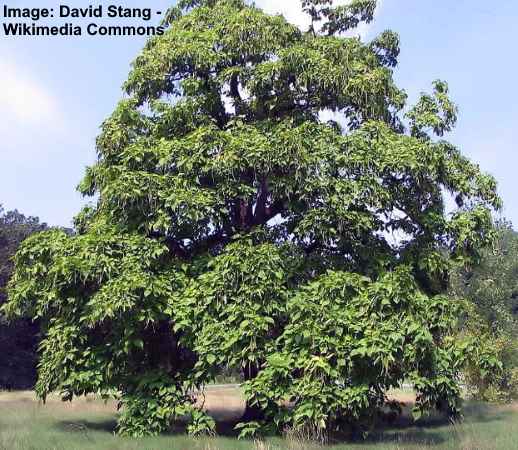
Northern Catalpa tree (Catalpa speciosa)
The northern catalpa tree is a large deciduous shade tree with vast, heart-shaped leaves and clusters of showy white flowers. This catalpa species is known for its narrow, oval canopy and spreading branches. Northern catalpas are the largest of the species and grow between 50 and 70 ft. (15 – 21 m) tall.
Northern catalpa trees grow in USDA zones 4 through 8. In garden landscapes, the ornamental trees thrive in well-drained, moist, loamy soil.
Northern catalpa trees are ideal shade trees for large front or back yards. The spreading branches create a crown of dense foliage between 20 and 50 ft. (6 – 15 m) wide.
The bark of northern catalpa trees is smooth and gray that becomes dark grayish-brown and fissures as the tree matures.
The leaves on northern catalpa trees are ovately shaped with a broad, rounded base and pointed tips. Its leaves are light green in spring and summer and turn a dull yellow color in the fall. Leaves measure up to 12” (30 cm) long and 8” (20 cm) at the widest point.
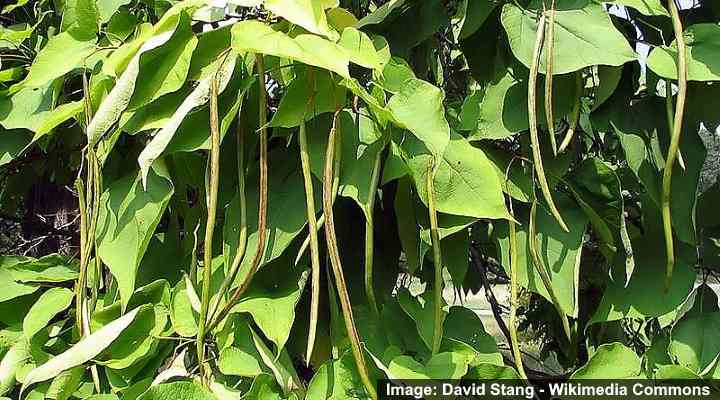
Catalpa speciosa leaves and seed pods
Northern catalpa tree seed pods are the longest of the trees in the genus Catalpa. The seed-containing pea-like capsules measure 8 to 20” (20 – 50 cm) long. Immature pods are green and gradually turn dark brown in the fall. In winter, the drooping brown seed pods look like dangling icicles.

Catalpa speciosa flowers and leaves
The flowers on the northern catalpa are funnel-shaped white flowers with ruffled petals. The flowers measure 2” (5 cm) across and grow in showy clusters. They bloom from late spring until early summer. Up close, you can see that these catalpa flowers have purple dotted patterns and yellow spots in the center.
Southern Catalpa (Catalpa bignonioides)
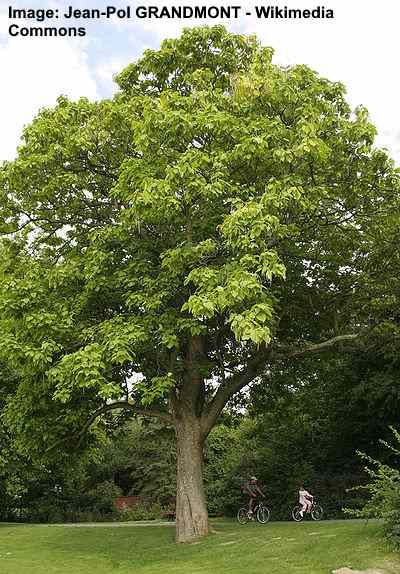
Southern Catalpa tree (Catalpa bignonioides)
The southern catalpa tree has an irregular, rounded canopy made up of heart-shaped glossy green leaves, trumpet-shaped flowers, and pea-like pods. This catalpa species is smaller than the northern species. It grows between 30 and 60 ft. (9 – 18 m) tall, and its dense shade canopy is 20 to 40 ft. (6 – 12 m) wide.
Southern catalpa trees thrive in USDA zones 5 through 9 and, like all deciduous trees, shed their leaves in the fall. The best place to grow southern catalpa trees is in full sun or partial shade and well-draining soil. Like the northern catalpa, the southern species grows best in fertile soil; however, it’s adaptable to most soil types.
In the southern states, Catalpa bignonioides is well-known for the catawba worms. Although these voracious caterpillars can quickly strip a catalpa tree of its leaves, fishermen regard the ‘worms’ as the best bait for fishing. Some even grow catalpa trees to harvest the catawba worms.
The southern catalpa tree is identifiable by its brown to gray bark. As the smooth bark on immature trees grows, it gradually becomes rough, forming rigid plates.
Southern catalpa leaves are a triangle shape with a broadly rounded base and short pointed tip. A characteristic of southern catalpa leaves is that they emit an unpleasant odor when crushed. Another unique feature of the leaves is that they produce nectar through small glands. Southern catalpa leaves measure 4” to 8” (10 – 20 cm) long and 6” to 8” (15 – 20 cm) wide.
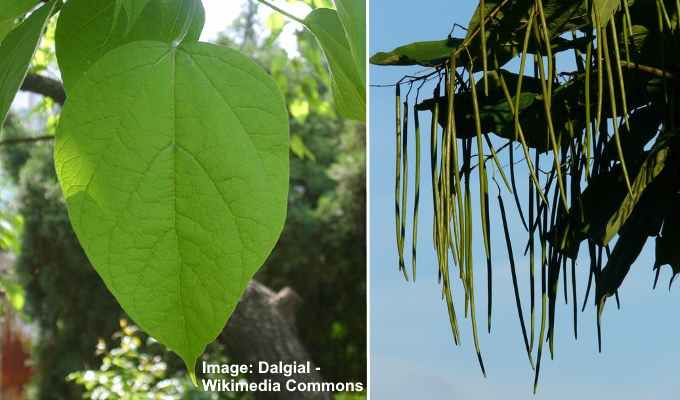
Catalpa bignonioides leaf and seed pods
Like the leaves, the seed capsules on southern catalpa trees are not as large as the northern species. The long slender seed pods are around 15” (37 cm) long. These brown pendulous pea-like pods are an interesting feature of the tree as they droop from bare branches throughout winter.
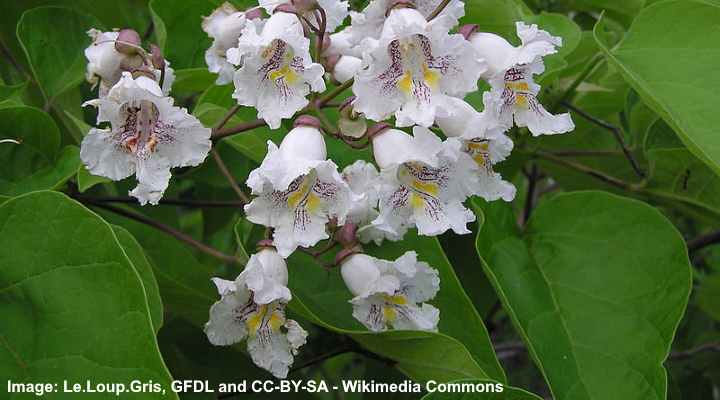
Catalpa bignonioides flowers
A spectacular characteristic of the southern catalpa tree is its masses of white conical flower clusters. Each showy flower cluster contains ten to 20 funnel-like flowers. Each small white flower has a purple pattern and yellowish-orange spots.
Chinese Catalpa (Catalpa ovata)
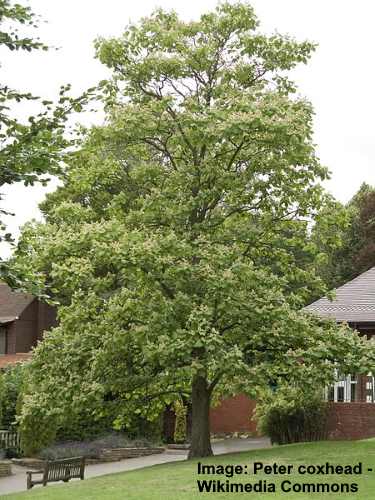
Chinese Catalpa tree (Catalpa ovata)
The Chinese catalpa is a small-medium deciduous tree with large broadly-ovate lobed leaves, small bell-shaped flowers, and narrow brown seed pods. The Catalpa ovata—or yellow catalpa—only grows between 20 and 30 ft. (6 – 9 m). Its spreading canopy grows up to 30 ft. (9 m) wide, making this species an excellent shade tree.
The Chinese catalpa thrives in USDA zones 4 through 8. The flowering tree grows best in full sun and can withstand growing in wet soil.
Unlike other Catalpa species, the Chinese catalpa has lobed leaves, giving each blade a wavy margin. Leaves measure up to 10” (25 cm) long and the same wide. This tree doesn’t have any particular fall foliage color.
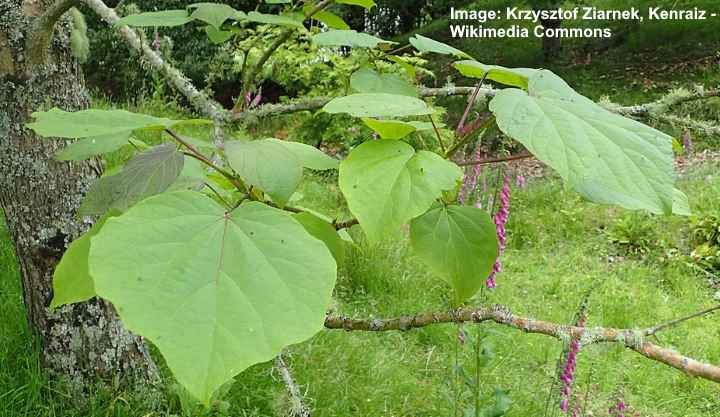
Catalpa ovata leaves
An identifying feature of the Chinese catalpa is its small orchid-like flowers. These dainty flowers bloom in late spring, forming small conical flowers clusters amongst the light green foliage. Compared to the northern catalpa and southern species, the Chinese catalpa flowers are not as showy.
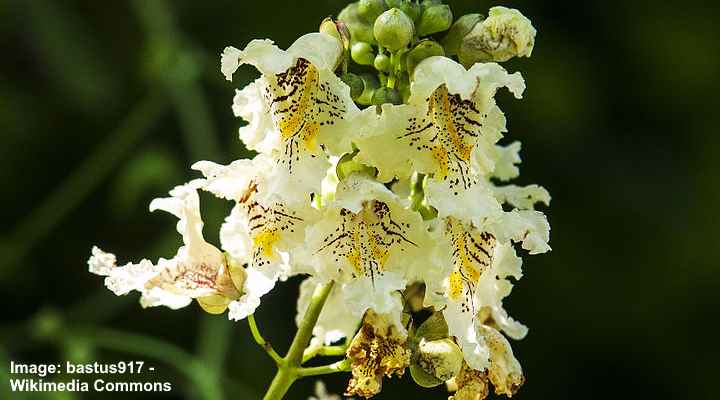
Catalpa ovata flowers
The seed pods of Chinese catalpa are very narrow and are 8″ to 12″ (20 – 30 cm) long.
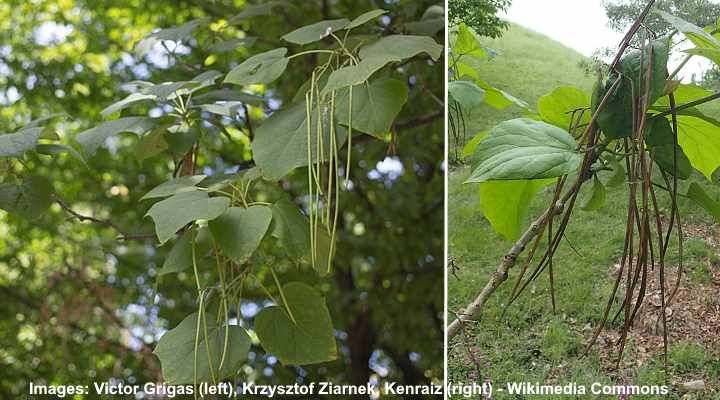
Catalpa ovata immature and mature seed pods
How to Plant a Catalpa Tree
The best place to plant a catalpa tree is in the sunniest location of your yard. The benefits of growing catalpa trees are that they are fast-growing and thrive in most types of soil. They perform just as well in moist ground as they do in damp, soggy soil.
It’s good to remember that the seeds easily spread and can become invasive in some regions.
How to Grow a Catalpa Tree from Seed
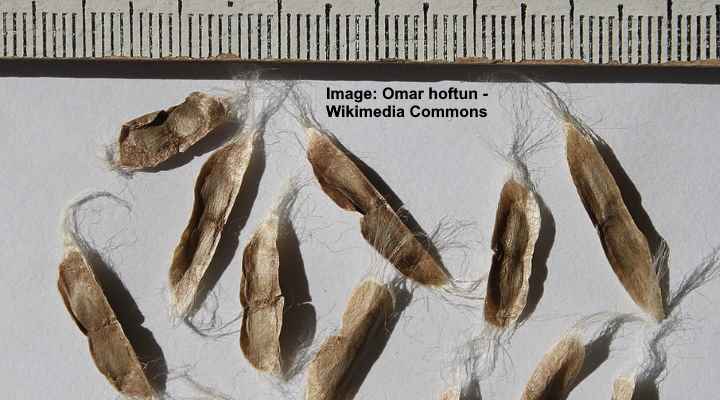
Southern Catalpa (Catalpa bignonioides) seeds
It’s easy to grow catalpa trees from seed. The winged seeds are readily available in the fall, where you can collect them from open pods. After drying the seeds in a cool, dry place during winter, they are ready for planting in spring.
Before planting catalpa seeds in the ground, they need exposure to the cold. Place the seeds in a refrigerator for a week or so before you plan to plant them.
In spring, plant three or four catalpa seeds in potting soil and cover them with 1” (2.5 cm) of soil. Put the small pots in a shaded place and keep the soil moist but never soggy.
After four to six weeks, the catalpa seedlings should be 2” or 3” (5 – 7.5 cm) tall and have a couple of leaves. Transplant each catalpa seedling to a larger, 3” (7.5 cm) pot with fresh, loose potting soil. Place the potted seedlings in a sheltered location outdoors and grow in pots during the first winter.
The young catalpa trees are ready for planting in the ground the following spring or summer.
How to Care for a Catalpa Tree
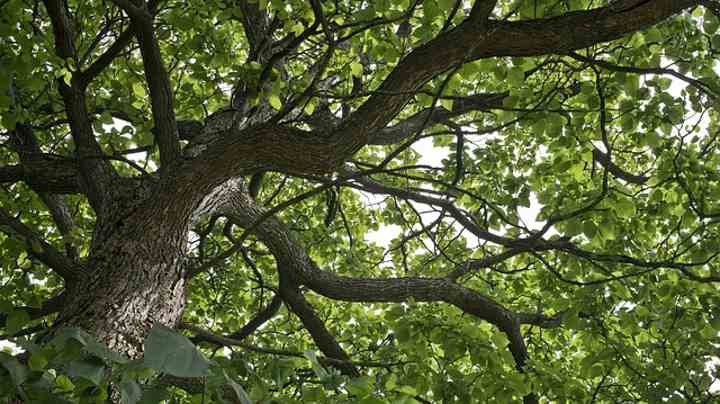
Catalpa trees grow well in sunny location and can tolerate wide range of soil types and conditions
Catalpa trees are resilient ornamental landscaping trees that thrive in most conditions. The lush green foliage, showy white flower clusters, and dangling slender brown seed pods give the tree year-long interest.
Here are some tips on how to care for northern catalpa or southern catalpa trees:
Light: Grow a catalpa tree in a sunny location where it gets around six hours of sunlight. These trees are also tolerant of partial shade.
Soil: Catalpa trees adapt to most soil types and grow in acidic or alkaline soil. Additionally, the large deciduous shade trees grow in clay, loamy, sandy, moist, and well-draining ground.
Water: Catalpa trees have average water needs and can tolerate a wide range of soil conditions—from occasional flooding to short periods of drought.
Temperature and humidity: Cold hardy to zones 4 and 5, northern and southern catalpa trees can withstand cold and extremely hot conditions.
Pruning: Catalpa trees only require pruning to remove dead, broken, or diseased branches. It’s also necessary to remove any deadwood from the crown as the brittle wood easily breaks off in strong winds.
Pests Affecting Catalpa Trees
The catalpa worm (Ceratomia catalpae) is the primary pest affecting the tree’s growth. If not controlled, the caterpillars can defoliate a tree in a few months.
To get rid of catalpa worms, shake the branches vigorously, so they drop to the ground. If the tree is small, you can spray it with neem oil, insecticidal soaps or Bacillus thuringiensis (Bt) which is a bacterium used as a biological pesticide. You can also till the soil around the tree in fall or early spring to kill the pupae.
Other common pests affecting trees in the genus Catalpa include aphids, mealybugs, and Japanese beetles. Caring for catalpa trees properly to ensure healthy, vigorous growth is the best way to protect them from pest damage.
To reduce the number of Japanese beetles in your garden, please read this article on how to get rid of lawn grubs.
Disease Affecting Catalpa Tree Growth
Powdery mildew is a typical fungal disease affecting foliage on catalpa trees. This white flour-like substance isn’t harmful to the tree’s leaves. However, it can make the tree look unsightly and sick.
Verticillium wilt is another fungal disease affecting catalpa trees. Signs of this tree disease include yellowing leaves that turn brown and fall off. In some cases, increasing nitrogen levels in the soil can help restore healthy growth.
Things to Consider When Growing a Catalpa
Northern catalpa (Catalpa speciosa) and southern catalpa (Catalpa bignonioides) trees are easy to grow in most landscapes. With minimal care, you can have a large shade tree in your backyard that flowers every spring.
The most significant thing to think about when growing a catalpa is the cleanup.
Catalpa trees tend to be messy trees that shed a load of large leaves in the fall. Also, in spring, the long seed pods drop and cause more mess. What’s more, the flowers and seed pods can be slippery and need clearing from sidewalks and driveways.
Some catalpa species are unique in that their leaves produce sticky nectar. This can drip onto parked vehicles, leaving behind an unsightly sticky residue.
Related articles:
- Types of Flowering Trees with Name and Picture for Easy Identification
- Types of Hawthorn Trees With Their Flowers and Leaves
- Acacia Trees: Types, Leaves, Flowers, Thorns
